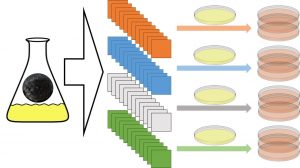The Sloan Foundation gave me one more thing to be grateful for this Thanksgiving: a grant to evaluate the impacts of different surface finishes on the indoor microbiome. My previous work identified a relationship between antimicrobial chemicals and antibiotic resistance genes in dust. This new project will build upon these results using an experimental system to evaluate if exposure to antimicrobial surfaces increases antibiotic resistance in indoor microbes.

This project will address the question: does the presence of synthetic or natural antimicrobials in surface finishes select for viable antibiotic-resistant microbes in the built environment? To answer this question, we will use bacterial cultures enriched from indoor dust and expose them to various surface finishes, including synthetic antimicrobial paint and natural clay paint with no added antimicrobial agent.
Paints often contain antimicrobial chemicals to extend their shelf life and prevent degradation, preserving the appearance of the paint once it has been applied. Many different antimicrobials, including the much-maligned triclosan, as well as newer ingredients like nano materials, or alkyl dimethyl benzyl quaternary ammonium chloride (aka “quat”). The long-term impacts of using such chemicals in the built environment on the development and spread of antibiotic resistance in the indoor microbiome is currently unknown.
The results of this work will help us understand how antibiotic resistance develops and spreads in the built environment. Ultimately, this work will enable consumers and manufacturers to make informed decisions about which materials to use in the built environment to promote desired microbial outcomes.
If you’re interested in this project or want to work on something similar, please get in touch with the Hartmann lab!